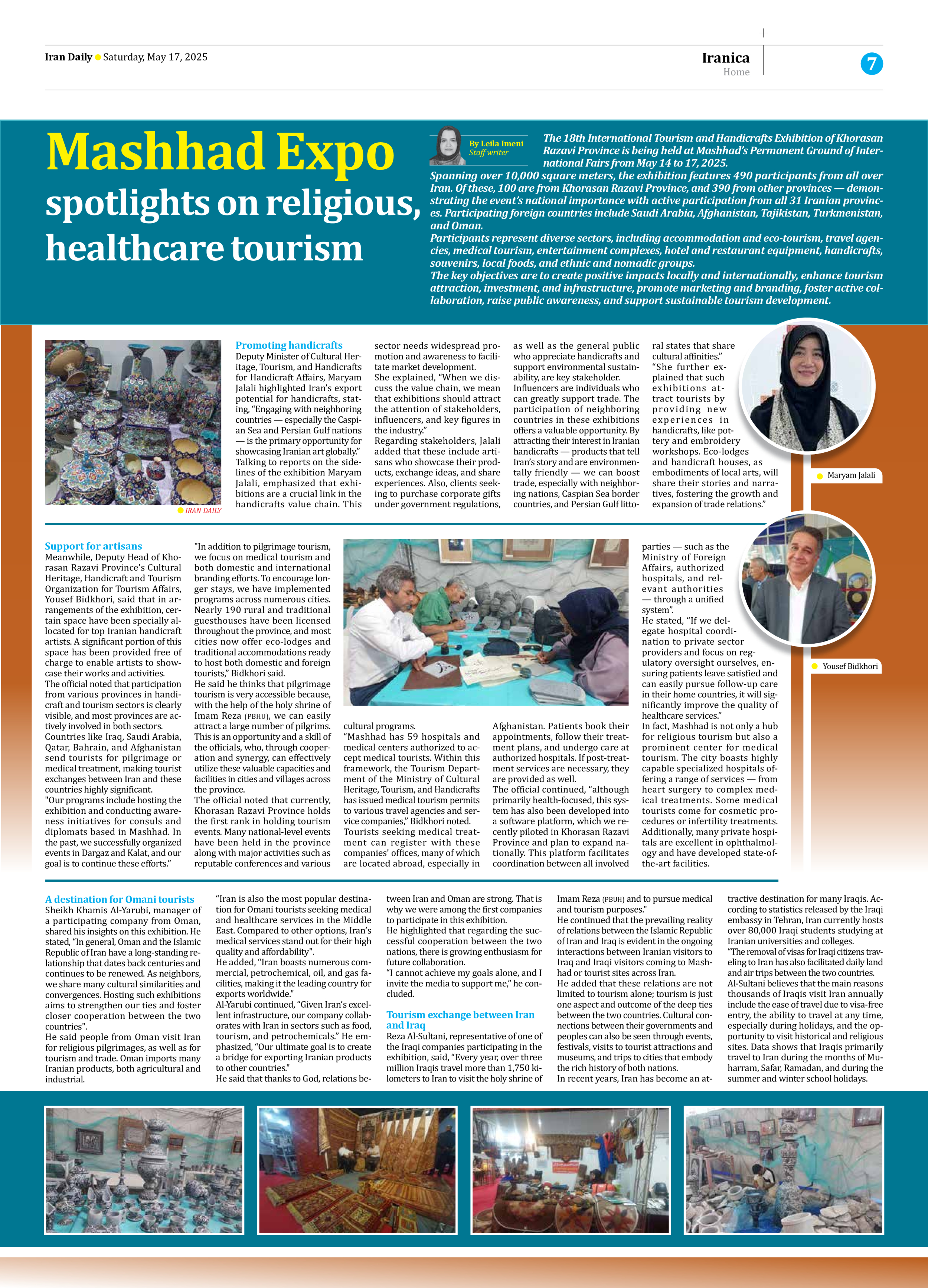
Mashhad Expo spotlights on religious, healthcare tourism
The 18th International Tourism and Handicrafts Exhibition of Khorasan Razavi Province is being held at Mashhad’s Permanent Ground of International Fairs from May 14 to 17, 2025. Spanning over 10,000 square meters, the exhibition features 490 participants from all over Iran. Of these, 100 are from Khorasan Razavi Province, and 390 from other provinces — demonstrating the event’s national importance with active participation from all 31 Iranian provinces. Participating foreign countries include Saudi Arabia, Afghanistan, Tajikistan, Turkmenistan, and Oman. Participants represent diverse sectors, including accommodation and eco-tourism, travel agencies, medical tourism, entertainment complexes, hotel and restaurant equipment, handicrafts, souvenirs, local foods, and ethnic and nomadic groups. The key objectives are to create positive impacts locally and internationally, enhance tourism attraction, investment, and infrastructure, promote marketing and branding, foster active collaboration, raise public awareness, and support sustainable tourism development.
By Leila Imeni
Staff writer
Maryam Jalali
Promoting handicrafts
Deputy Minister of Cultural Heritage, Tourism, and Handicrafts for Handicraft Affairs, Maryam Jalali highlighted Iran’s export potential for handicrafts, stating, “Engaging with neighboring countries — especially the Caspian Sea and Persian Gulf nations — is the primary opportunity for showcasing Iranian art globally.”
Talking to reports on the sidelines of the exhibition Maryam Jalali, emphasized that exhibitions are a crucial link in the handicrafts value chain. This sector needs widespread promotion and awareness to facilitate market development.
She explained, “When we discuss the value chain, we mean that exhibitions should attract the attention of stakeholders, influencers, and key figures in the industry.”
Regarding stakeholders, Jalali added that these include artisans who showcase their products, exchange ideas, and share experiences. Also, clients seeking to purchase corporate gifts under government regulations, as well as the general public who appreciate handicrafts and support environmental sustainability, are key stakeholder.
Influencers are individuals who can greatly support trade. The participation of neighboring countries in these exhibitions offers a valuable opportunity. By attracting their interest in Iranian handicrafts — products that tell Iran’s story and are environmentally friendly — we can boost trade, especially with neighboring nations, Caspian Sea border countries, and Persian Gulf littoral states that share cultural affinities.”
“She further explained that such exhibitions attract tourists by providing new experiences in handicrafts, like pottery and embroidery workshops. Eco-lodges and handicraft houses, as embodiments of local arts, will share their stories and narratives, fostering the growth and expansion of trade relations.”
Yousef Bidkhori
Support for artisans
Meanwhile, Deputy Head of Khorasan Razavi Province’s Cultural Heritage, Handicraft and Tourism Organization for Tourism Affairs, Yousef Bidkhori, said that in arrangements of the exhibition, certain space have been specially allocated for top Iranian handicraft artists. A significant portion of this space has been provided free of charge to enable artists to showcase their works and activities.
The official noted that participation from various provinces in handicraft and tourism sectors is clearly visible, and most provinces are actively involved in both sectors.
Countries like Iraq, Saudi Arabia, Qatar, Bahrain, and Afghanistan send tourists for pilgrimage or medical treatment, making tourist exchanges between Iran and these countries highly significant.
"Our programs include hosting the exhibition and conducting awareness initiatives for consuls and diplomats based in Mashhad. In the past, we successfully organized events in Dargaz and Kalat, and our goal is to continue these efforts.”
"In addition to pilgrimage tourism, we focus on medical tourism and both domestic and international branding efforts. To encourage longer stays, we have implemented programs across numerous cities. Nearly 190 rural and traditional guesthouses have been licensed throughout the province, and most cities now offer eco-lodges and traditional accommodations ready to host both domestic and foreign tourists,” Bidkhori said.
He said he thinks that pilgrimage tourism is very accessible because, with the help of the holy shrine of Imam Reza (PBHU), we can easily attract a large number of pilgrims. This is an opportunity and a skill of the officials, who, through cooperation and synergy, can effectively utilize these valuable capacities and facilities in cities and villages across the province.
The official noted that currently, Khorasan Razavi Province holds the first rank in holding tourism events. Many national-level events have been held in the province along with major activities such as reputable conferences and various cultural programs.
“Mashhad has 59 hospitals and medical centers authorized to accept medical tourists. Within this framework, the Tourism Department of the Ministry of Cultural Heritage, Tourism, and Handicrafts has issued medical tourism permits to various travel agencies and service companies,” Bidkhori noted.
Tourists seeking medical treatment can register with these companies’ offices, many of which are located abroad, especially in Afghanistan. Patients book their appointments, follow their treatment plans, and undergo care at authorized hospitals. If post-treatment services are necessary, they are provided as well.
The official continued, “although primarily health-focused, this system has also been developed into a software platform, which we recently piloted in Khorasan Razavi Province and plan to expand nationally. This platform facilitates coordination between all involved parties — such as the Ministry of Foreign Affairs, authorized hospitals, and relevant authorities — through a unified system”.
He stated, “If we delegate hospital coordination to private sector providers and focus on regulatory oversight ourselves, ensuring patients leave satisfied and can easily pursue follow-up care in their home countries, it will significantly improve the quality of healthcare services.”
In fact, Mashhad is not only a hub for religious tourism but also a prominent center for medical tourism. The city boasts highly capable specialized hospitals offering a range of services — from heart surgery to complex medical treatments. Some medical tourists come for cosmetic procedures or infertility treatments. Additionally, many private hospitals are excellent in ophthalmology and have developed state-of-the-art facilities.
A destination for Omani tourists
Sheikh Khamis Al-Yarubi, manager of a participating company from Oman, shared his insights on this exhibition. He stated, “In general, Oman and the Islamic Republic of Iran have a long-standing relationship that dates back centuries and continues to be renewed. As neighbors, we share many cultural similarities and convergences. Hosting such exhibitions aims to strengthen our ties and foster closer cooperation between the two countries".
He said people from Oman visit Iran for religious pilgrimages, as well as for tourism and trade. Oman imports many Iranian products, both agricultural and industrial.
“Iran is also the most popular destination for Omani tourists seeking medical and healthcare services in the Middle East. Compared to other options, Iran’s medical services stand out for their high quality and affordability".
He added, “Iran boasts numerous commercial, petrochemical, oil, and gas facilities, making it the leading country for exports worldwide."
Al-Yarubi continued, “Given Iran’s excellent infrastructure, our company collaborates with Iran in sectors such as food, tourism, and petrochemicals.” He emphasized, “Our ultimate goal is to create a bridge for exporting Iranian products to other countries."
He said that thanks to God, relations between Iran and Oman are strong. That is why we were among the first companies to participate in this exhibition.
He highlighted that regarding the successful cooperation between the two nations, there is growing enthusiasm for future collaboration.
“I cannot achieve my goals alone, and I invite the media to support me,” he concluded.
Tourism exchange between Iran and Iraq
Reza Al-Sultani, representative of one of the Iraqi companies participating in the exhibition, said, “Every year, over three million Iraqis travel more than 1,750 kilometers to Iran to visit the holy shrine of Imam Reza (PBUH) and to pursue medical and tourism purposes."
He continued that the prevailing reality of relations between the Islamic Republic of Iran and Iraq is evident in the ongoing interactions between Iranian visitors to Iraq and Iraqi visitors coming to Mashhad or tourist sites across Iran.
He added that these relations are not limited to tourism alone; tourism is just one aspect and outcome of the deep ties between the two countries. Cultural connections between their governments and peoples can also be seen through events, festivals, visits to tourist attractions and museums, and trips to cities that embody the rich history of both nations.
In recent years, Iran has become an attractive destination for many Iraqis. According to statistics released by the Iraqi embassy in Tehran, Iran currently hosts over 80,000 Iraqi students studying at Iranian universities and colleges.
“The removal of visas for Iraqi citizens traveling to Iran has also facilitated daily land and air trips between the two countries.
Al-Sultani believes that the main reasons thousands of Iraqis visit Iran annually include the ease of travel due to visa-free entry, the ability to travel at any time, especially during holidays, and the opportunity to visit historical and religious sites. Data shows that Iraqis primarily travel to Iran during the months of Muharram, Safar, Ramadan, and during the summer and winter school holidays.







